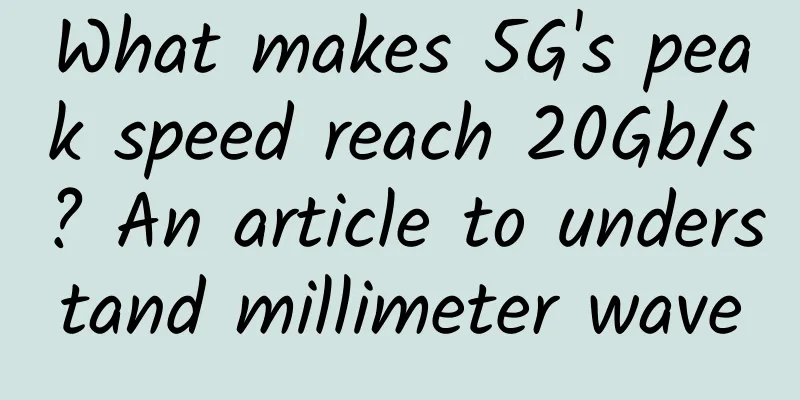What makes 5G's peak speed reach 20Gb/s? An article to understand millimeter wave

|
With the explosion of video content, today's mobile users are no longer satisfied with the current Internet speed and hope that telecom operators can provide faster data transmission speeds and more reliable network services. The next generation of communication technology 5G was born in this context. Although 5G is still in the planning stage, the entire industry is working together to determine the final form of 5G. However, all participants in this industry must agree on this point: As the number of mobile users and their demands rise, 5G must handle more traffic faster than today's cellular network base stations. To make this possible, wireless communications engineers are designing a whole new set of technologies that will allow 5G data transmissions to be transmitted with latency of less than 1 millisecond (compared to about 70 milliseconds on today’s 4G networks) and peak data download speeds of up to 20 Gb/s (compared to 1 Gb/s on 4G). It is not yet clear which technologies will be the most critical in 5G in the long run, but some early technologies have emerged, including millimeter wave, small base stations, massive MIMO, full duplex and beamforming. One of the most significant problems facing today's wireless networks is that more people and devices are consuming far more data than before, but they are still crowded into the same bands of radio spectrum that telecom companies have always used. This means that everyone is allocated a limited amount of bandwidth, resulting in slow speeds and frequent dropped calls. As the number of devices connected to wireless networks increases, the problem of scarce spectrum resources becomes increasingly prominent. At least for now, we can only share limited bandwidth on an extremely narrow spectrum, which greatly affects the user experience. Millimeter wave technology is the key to solving this problem. What is millimeter wave? Compared to the sub-5Ghz bands previously used for mobile devices, millimeter waves transmit at frequencies between 30GHz and 300GHz. They are called millimeter waves because the wavelengths of these bands are between 1mm and 10mm, while the wavelengths of radio waves used in smartphones today are mostly tens of centimeters. Until now, millimeter waves have only been used in radar systems and satellites. Some cellular network providers already use millimeter waves to transmit data between fixed points, such as two base stations, but using millimeter waves to connect mobile users to nearby base stations is a completely new approach. What are the advantages of millimeter wave technology? Some media have previously reported that there are generally two ways to increase the transmission rate of wireless transmission: one is to increase the spectrum utilization rate, and the other is to increase the spectrum bandwidth. Compared with improving the spectrum utilization rate, the method of increasing the spectrum bandwidth is simpler and more direct. If the spectrum utilization rate remains unchanged, doubling the available bandwidth can double the data transmission rate. But the problem is that the commonly used frequency bands below 5GHz are already very crowded. Where can we find new spectrum resources? 5G uses millimeter waves to increase the rate through the second method. According to the communication principle, the maximum signal bandwidth of wireless communication is about 5% of the carrier frequency, so the higher the carrier frequency, the larger the achievable signal bandwidth. Among the millimeter wave bands, the 28GHz band and the 60GHz band are the two bands with the greatest potential for use in 5G. The available spectrum bandwidth of the 28GHz band can reach 1GHz, while the available signal bandwidth of each channel in the 60GHz band reaches 2GHz (the entire 9GHz available spectrum is divided into four channels). In comparison, the highest frequency carrier of 4G-LTE is around 2GHz, and the available spectrum bandwidth is only 100MHz. Therefore, if the millimeter wave band is used, the spectrum bandwidth can be easily increased by 10 times, and the transmission rate can also be greatly improved. What are the disadvantages of millimeter wave technology? Despite its advantages, millimeter waves also have a major disadvantage, which is that they don't easily pass through buildings or obstacles and can be absorbed by leaves and rain. This is why 5G networks will use small base stations to strengthen traditional cellular towers. Since the frequency of millimeter waves is very high and the wavelength is very short, the antenna size can be made very small, which is the basis for the deployment of small base stations. It is foreseeable that in the future, 5G mobile communications will no longer rely on the deployment architecture of large base stations. A large number of small base stations will become a new trend, which can cover the peripheral communications that large base stations cannot reach. Li Yile, the author of Silicon Say, once said that at present, the major manufacturers' plan for the use of 5G frequency bands is to use the more traditional frequency bands below 6GHz in open outdoor areas to ensure signal coverage, and to use micro base stations plus millimeter wave technology to achieve ultra-high-speed data transmission indoors. With millimeter wave and other 5G technologies, engineers hope that 5G networks will not only provide services for smartphone users, but also play an important role in areas such as self-driving cars, virtual reality and the Internet of Things. Researchers and companies have set high expectations for 5G, promising ultra-low latency and record data speeds for consumers. If they can solve the remaining challenges and figure out how to make the entire system work together, super-fast 5G services could be commercially available within the next five years. |
>>: New 5G standards: Personal network speeds no less than 100 Mbps downlink and 50 Mbps uplink
Recommend
PIGYun: Los Angeles, USA/Korea VPS 60% off in July, monthly payment starts from 14.4 yuan
PIGYun is a Chinese merchant founded in 2019, pro...
How fast is 6G? You really should know in advance
When people are looking forward to the wonderful ...
The most comprehensive wireless bridge knowledge in history, just save this article!
Many friends asked about the knowledge related to...
Is our 5G field booming? Many regions are actively deploying, and the future development potential is worth paying attention to
As an important direction for the evolution and u...
Is 5G not the only option for the Internet of Things?
While the Internet of Things has the potential to...
CloudSilk: 160 yuan/year-512MB/10G SSD/[email protected]/San Jose 4837/optional AS9929
CloudSilk is a domestic hosting company establish...
The Ministry of Industry and Information Technology interprets eight hot spots in the development of industrial communications in the first quarter
On April 25, the State Council Information Office...
Shandong issues six standards for e-government cloud platform construction
Recently, Shandong issued six standards in the fi...
HTTP, TCP, IP, and Ethernet in one article
This article is reprinted from the WeChat public ...
[Important] IDC and Deepin Technology jointly released the technical white paper "Three Highs Application Delivery to Realize the All-Round Experience of Digital Natives"
The global economy is entering the digital econom...
6 AI Elements You Need for a Wireless Network Strategy
Thanks to advances in artificial intelligence (AI...
RackNerd "Memorial Day" Sale: Los Angeles VPS from $14.99 per year
RackNerd has launched a Memorial Day promotion, w...
The United States has approved 6G trials. Is this a far-sighted move or a desperate attempt?
Recently, US President Trump announced the approv...
Don't just look at the wireless router antenna. WiFi signal is only related to this parameter.
When buying a wireless router, should you buy one...
The unlimited package has been cancelled? What does this mean for 5G?
It is reported that China Telecom announced that ...





![[Black Friday] Hostons: 25% off VPS/VDS starting from $12/year, free double hard disk + double monthly traffic @10Gbps, multiple data centers in Los Angeles/Salt Lake City, etc.](/upload/images/67cabcfc5d86b.webp)
![[Black Friday] DesiVPS: 1Gbps unlimited traffic high-security VPS annual payment of $26.99, free IP change once a month, Los Angeles data center](/upload/images/67cac01b325a5.webp)


